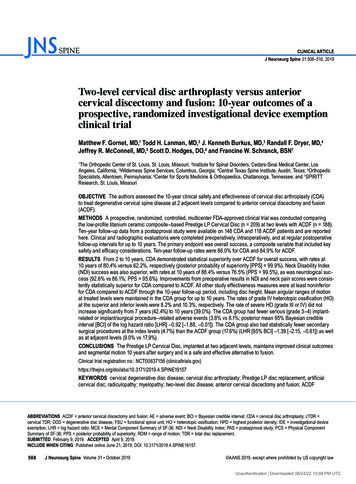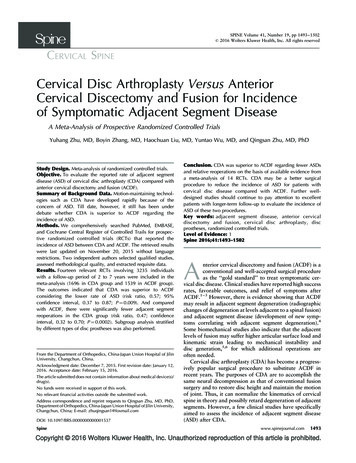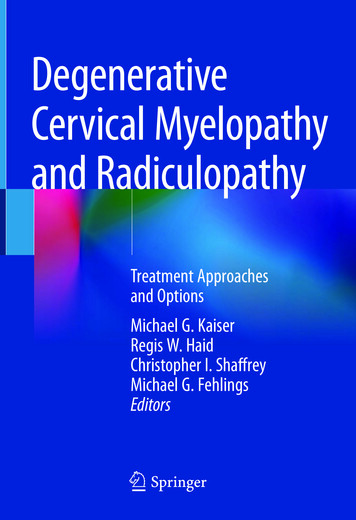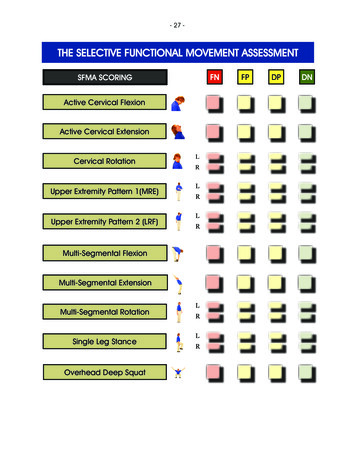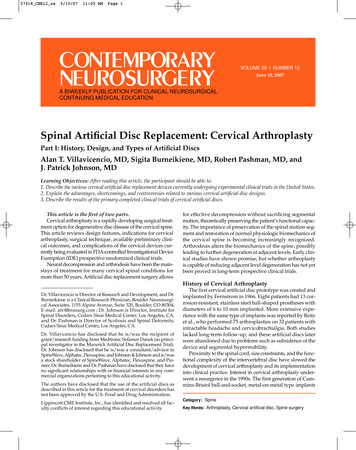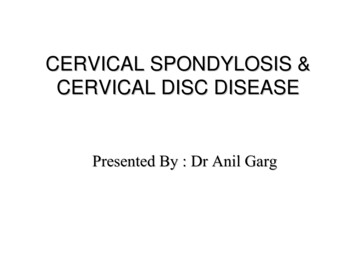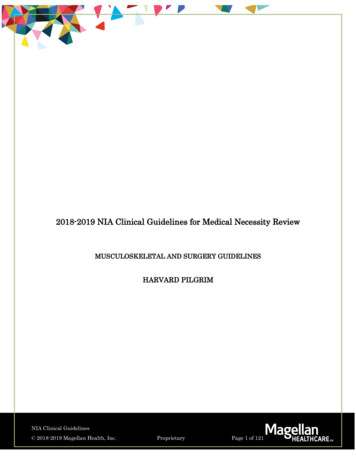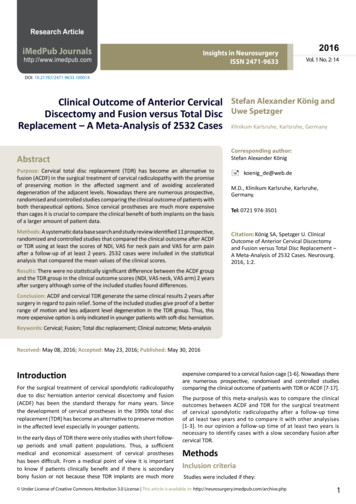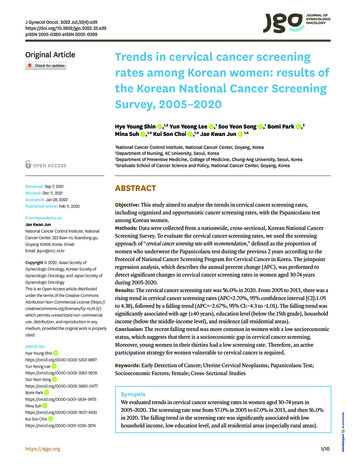
Transcription
J Gynecol Oncol. 2022 39pISSN 2005-0380·eISSN 2005-0399Original ArticleTrends in cervical cancer screeningrates among Korean women: results ofthe Korean National Cancer ScreeningSurvey, 2005–2020Hye Young Shin ,1,2 Yun Yeong Lee ,1 Soo Yeon SongMina Suh ,1,4 Kui Son Choi ,1,4 Jae Kwan Jun 1,4,1 Bomi Park,3National Cancer Control Institute, National Cancer Center, Goyang, KoreaDepartment of Nursing, KC University, Seoul, Korea3Department of Preventive Medicine, College of Medicine, Chung-Ang University, Seoul, Korea4Graduate School of Cancer Science and Policy, National Cancer Center, Goyang, Korea12Received: Sep 7, 2021Revised: Dec 11, 2021Accepted: Jan 28, 2022Published online: Feb 11, 2022Correspondence toJae Kwan JunNational Cancer Control Institute, NationalCancer Center, 323 Ilsan-ro, Ilsandong-gu,Goyang 10408, Korea. Email:Email: jkjun@ncc.re.krCopyright 2022. Asian Society ofGynecologic Oncology, Korean Society ofGynecologic Oncology, and Japan Society ofGynecologic OncologyThis is an Open Access article distributedunder the terms of the Creative CommonsAttribution Non-Commercial License hich permits unrestricted non-commercialuse, distribution, and reproduction in anymedium, provided the original work is properlycited.ORCID iDsHye Young Shinhttps://orcid.org/0000-0002-5353-8897Yun Yeong Leehttps://orcid.org/0000-0002-3263-920XSoo Yeon Songhttps://orcid.org/0000-0002-5860-0477Bomi Parkhttps://orcid.org/0000-0001-5834-9975Mina Suhhttps://orcid.org/0000-0002-9557-4933Kui Son jgo.orgABSTRACTObjective: This study aimed to analyze the trends in cervical cancer screening rates,including organized and opportunistic cancer screening rates, with the Papanicolaou testamong Korean women.Methods: Data were collected from a nationwide, cross-sectional, Korean National CancerScreening Survey. To evaluate the cervical cancer screening rates, we used the screeningapproach of “cervical cancer screening rate with recommendation,” defined as the proportion ofwomen who underwent the Papanicolaou test during the previous 2 years according to theProtocol of National Cancer Screening Program for Cervical Cancer in Korea. The joinpointregression analysis, which describes the annual percent change (APC), was performed todetect significant changes in cervical cancer screening rates in women aged 30-74 yearsduring 2005-2020.Results: The cervical cancer screening rate was 56.0% in 2020. From 2005 to 2013, there was arising trend in cervical cancer screening rates (APC 2.70%, 95% confidence interval [CI]:1.05to 4.38), followed by a falling trend (APC 2.67%, 95% CI: 4.3 to 1.01). The falling trend wassignificantly associated with age ( 40 years), education level (below the 15th grade), householdincome (below the middle-income level), and residence (all residential areas).Conclusion: The recent falling trend was more common in women with a low socioeconomicstatus, which suggests that there is a socioeconomic gap in cervical cancer screening.Moreover, young women in their thirties had a low screening rate. Therefore, an activeparticipation strategy for women vulnerable to cervical cancer is required.Keywords: Early Detection of Cancer; Uterine Cervical Neoplasms; Papanicolaou Test;Socioeconomic Factors; Female; Cross-Sectional StudiesSynopsisWe evaluated trends in cervical cancer screening rates in women aged 30–74 years in2005–2020. The screening rate rose from 57.0% in 2005 to 67.0% in 2013, and then 56.0%in 2020. The falling trend in the screening rate was significantly associated with lowhousehold income, low education level, and all residential areas (especially rural areas).1/10
Trends in cervical cancer screening ratesJae Kwan s study was supported by a Grant-in Aidfor Cancer Research and Control from theNational Cancer Center of Korea (Grant No.2210771-1). Funding bodies have no role in thestudy design, study setting, analysis, or writingof the manuscript.Conflict of InterestNo potential conflict of interest relevant to thisarticle was reported.Author ContributionsConceptualization: S.M., C.K.S., J.J.K.;Formal analysis: Y.L.Y., S.S.Y., P.B.; Projectadministration: J.J.K.; Validation: J.J.K.;Writing - original draft: S.H.Y.; Writing - review& editing: S.H.Y., S.M., C.K.S., J.J.K.INTRODUCTIONGlobally, approximately 570,000 new cases of cervical cancer were diagnosed and 311,000women died due to cervical cancer in 2018 [1]. Although the incidence of cervical cancerin Korea is lower than that in other developed countries, new cases and deaths have beenconsistently reported until recently: 3,500 new cases and 845 deaths in 2018 [2].The Papanicolaou test (Pap test) is an effective method for screening cervical cancer cases[3,4]. The Korean Guideline for Cervical Cancer Screening and the Protocol of NationalCancer Screening Program (NCSP) for cervical cancer have been developed based on the Paptest (Table 1) [5-7]. In an organized screening system, the NCSP has offered to conduct a freePap test every 2 years for all women aged above 30 years since 2002; from 2016, this programalso included women in their 20s as target screening recipients [7]. In Korea, cervicalcancer screening using the Pap test is also available for the opportunistic screening system.Opportunistic cancer screening entirely depends on individuals’ decisions regarding the testmethods and frequency at their own expense. Thus, there is a need for a report on cervicalcancer screening rates among all Korean women, which will be a more accurate estimate, asit integrates data from both organized and opportunistic cancer screening systems.The present study aimed to analyze the trends in cervical cancer screening rates, includingboth the organized and opportunistic cancer screening programs, with the Pap test amongKorean women during 2005–2020.MATERIALS AND METHODS1. Ethical approval statementThe present study was approved by the National Cancer Center Institutional Review Board ofKorea (approval number: NCC2019-0233). Subjects consented to participate in the survey forpublic purpose, and the requirement for written consent was waived.2. Study populationWe used data from the Korean National Cancer Screening Survey (KNCSS), which is anationwide cross-sectional survey conducted every year since 2004 and evaluates bothorganized and opportunistic cancer screening rates among the target screening population of5 cancers (stomach, liver, colorectal, breast, and cervical cancers). The KNCSS participantswere selected through stratified multistage and random sampling according to thegeographical area, age, and sex. A detailed description of the target sampling process isprovided elsewhere [7]. For data collection, the professional research agency staff visitedthe selected participants’ houses at least 3 times and conducted face-to-face interviews withthem. However, because data collection in 2004 was carried out through computer-assistedTable 1. The Korean Guideline for Cervical Cancer Screening and the Protocol issued by the NCSP for cervical cancerYear of issueKorean Guideline for Cervical Cancer ScreeningProtocol of NCSP for Cervical Cancer2001 [5]2015 [6]20022016Target populationWomen aged 20 yrWomen aged 20–74* yrWomen aged 30 yrWomen aged 20 yrTestPap testPap test or liquid-based cytologyPap testPap testInterval1 yr3 yr2 yr2 yrNCSP, National Cancer Screening Program; Pap, Papanicolaou.*Women aged 75 years who have undergone 3 consecutive Pap tests with negative results within 10 years should stop participating in cervical cancer jgo.2022.33.e392/10
Trends in cervical cancer screening ratestelephone interviews, the current analysis excluded that data (Table S1). Women aged 20–29years were excluded from the trend analysis of cervical cancer screening rates because theywere included as participants of the KNCSS since 2014, and thus, only the screening rates foreach year were analyzed.3. Study variablesThe KNCSS assesses 2 types of cervical cancer screening rates: lifetime screening rates andscreening rates with recommendation. Regarding the lifetime cervical cancer screeningrate, study participants were asked the first question, “Have you ever had a cervical cancerscreening with the Pap test?” If the answer was “Yes,” then the participants were asked thefollowing question: “When was the last time you had the Pap test?” Based on these questionsand answers, we developed an operational definition for “cervical cancer screening rate withrecommendation,” defined as the proportion of women who underwent the Pap test during theprevious 2 years according to the Protocol of NCSP for Cervical Cancer in Korea. To evaluatethe cervical cancer screening rates in our study, we used the “cervical cancer screening rate withrecommendation” approach.To measure the cervical cancer screening rate according to the socioeconomic status, weused the education level and monthly household income variables. These variables havebeen mainly used to measure the screening rate according to socioeconomic status [8,9].The education level was categorized into middle school (11 years or less), high school (12–15years), and university or higher (16 years or more). Monthly household income was classifiedinto tertiles. The first tertile represented the low-income level. The second tertile representedthe middle-income level, and the third tertile represented the high-income level.In addition, the cervical cancer screening rate was assessed in relation to age and residentialarea (metropolitan, urban, rural).4. Data analysisTrends in cervical cancer screening rates were estimated using joinpoint regression withJoinpoint Desktop Software (ver. 4.7.0.0), from the National Cancer Institute (NCI). Thejoinpoints with the best fitting points were chosen with a significant change in the rate(p 0.05) over the study period [10]. Here, the number of joinpoints from 0 (representing astraight line) to 1 as the best fitting point and the annual percentage change (APC) in eachtrend segment were estimated. The average APC (AAPC) was calculated as the average trendfor the period 2005–2020 [10]. Statistically significant differences in APC and AAPC wereestimated at a 95% confidence interval (CI), and the p-value (p 0.05) was determined. Wedescribed the trends with estimates of APC based on the cancer trends progress report by theNCI, as follows [11]: 1) STABLE: 0.5 APC 0.5, with no statistical significance; 2) NONSIGNIFICANT CHANGE: APC 0.5 or APC 0.5, with no statistical significance; 3) RISING: astatically significant APC of 0; 4) FALLING: a statistically significant APC of 0. In addition,we performed descriptive statistics to analyze the annual cervical cancer screening rate andgeneral characteristics of the participants using SAS software (ver. 9.4; SAS Institute, Cary,NC, USA), and the results are presented in Tables S1 and 2.33.e393/10
Trends in cervical cancer screening ratesRESULTSThe results of the trend analysis showed that the cervical cancer screening rate started at57.0% in 2005 and showed a rising trend until 2013 (APC 2.70%, 95% CI:1.05 to 4.38),followed by a falling trend thereafter, reaching 56.0% in 2020 (APC 2.67%, 95% CI: 4.3to 1.01) (Fig. 1 and Table S2). As for the cervical cancer screening rate according to age, afalling trend was noted in the recent years in all women aged above 40 years, whereas a stabletrend was noted in women aged 30 years old during the entire period (APC 0.40% during2005–2020) (Fig. 2). Moreover, the groups with more than the 16th education grade and highincome level showed stable trends; except these groups, we observed falling trends in cervicalcancer screening rates in recent years in all subgroups according to education level, monthlyhousehold income level, and residential area (Figs. 3-5). Additionally, 500 women in their 20shave been surveyed each year since 2014. Their screening rates for the period of 2014–2020were 12.8%, 15.5%, 29.7%, 33.0%, 20.9%, 23.2%, and 26.0% (data not shown).DISCUSSIONIn the present study, the cervical cancer screening rate showed a rising trend from 2005to 2013, followed by a falling trend from 2013 to 2020. In particular, the groups with a lowsocioeconomic status (low income and low education level) had the lowest cervical cancerscreening rate, when compared to the other groups; this rate then increased sharply until theearly and mid-2010s, and then decreased sharply. The women in their thirties had a stablelow screening rate trend.In the most recent years, the cervical cancer screening rate has decreased from 67.0% in 2013to 56.0% in 2020 (Table S2). Unfortunately, the latest screening rate was almost the sameas the initial screening rate (57.0% in 2005) when the KNCSS was started. This falling trendis in accordance with previously published data from other countries. The National HealthSystem (NHS) in England reported that the cervical cancer screening rate recommended byAll participantsCancer screening rate (%)1008060402002005–2013APC 2.70* [95% CI: 1.05 to 4.38]2013–2020APC 2.67* [95% CI: 4.30 to 1.01]2005 2006 2007 2008 2009 2010 2011 2012 2013 2014 2015 2016 2017 2018 2019 2020YearFig. 1. Trends in cervical cancer screening rates during 2005–2020. The solid green line denotes a rising trend;the solid pink line denotes a falling trend.APC, annual percent change; CI, confidence interval.*p for trends in APCs of 022.33.e394/10
Trends in cervical cancer screening rates30–39 years old100806040200BCancer screening rate (%)Cancer screening rate (%)A2005–2020APC 0.40 [95% CI: 1.40 to 0.61]1008060402002005 2006 2007 2008 2009 2010 2011 2012 2013 2014 2015 2016 2017 2018 2019 202040–49 years old2005–2013APC 2.21* [95% CI: 0.42 to 4.03]2005 2006 2007 2008 2009 2010 2011 2012 2013 2014 2015 2016 2017 2018 2019 2020YearYear50–59 years old1008060402002005–2012APC 3.10 [95% CI: 0.25 to 6.56]2012–2020APC 2.26* [95% CI: 4.37 to 0.12]2005 2006 2007 2008 2009 2010 2011 2012 2013 2014 2015 2016 2017 2018 2019 2020DCancer screening rate (%)Cancer screening rate (%)C100Cancer screening rate (%)60–69 years old806040200YearE2013–2020APC 2.53* [95% CI: 4.49 to 0.53]2005–2016APC 3.10* [95% CI: 1.13 to 5.12]2016–2020APC 7.35* [95% CI: 13.18 to 1.13]2005 2006 2007 2008 2009 2010 2011 2012 2013 2014 2015 2016 2017 2018 2019 2020Year70–74 years old1008060402002005–2016APC 5.65* [95% CI: 1.77 to 9.69]2016–2020APC 12.03* [95% CI: 20.36 to 2.82]2005 2006 2007 2008 2009 2010 2011 2012 2013 2014 2015 2016 2017 2018 2019 2020YearFig. 2. Trends in cervical cancer screening rates by age group during 2005–2020. The solid green line denotes a rising trend; the solid pink line denotes a fallingtrend; the dashed gray line denotes a non-significant change.APC, annual percent change; CI, confidence interval.*p for trends in APCs of 0.05.the United Kingdom National Screening Committee decreased from 75.7% in 2011 to 72.2%in 2020 among women aged 25–64 years [12]. The National Health Interview Survey in theUnited States reported that the cervical cancer screening rate according to U.S. PreventiveServices Task Force (USPSTF) screening recommendations was 82.9% among women aged21–65 years in 2018, which was seen to be slightly increasing recently, but overall, it was lowerthan the 85.3% reported in 2005 [13].A sharp falling trend in the cervical cancer screening rate among groups with a lowsocioeconomic status was evident since the early and mid-2010s in our study, which 022.33.e395/10
Trends in cervical cancer screening ratesLow income level1008060402002005–2014APC 4.15* [95% CI: 1.46 to 6.90]2014–2020APC 4.91* [95% CI: 8.67 to 1.00]2005 2006 2007 2008 2009 2010 2011 2012 2013 2014 2015 2016 2017 2018 2019 2020BCancer screening rate (%)Cancer screening rate (%)A100806040200YearCancer screening rate (%)CMiddle income level2005–2012APC 3.29* [95% CI: 1.16 to 5.46]2012–2020APC 2.37* [95% CI: 3.79 to 0.93]2005 2006 2007 2008 2009 2010 2011 2012 2013 2014 2015 2016 2017 2018 2019 2020YearHigh income level1008060402002005–2020APC 0.16 [95% CI: 0.92 to 0.61]2005 2006 2007 2008 2009 2010 2011 2012 2013 2014 2015 2016 2017 2018 2019 2020YearFig. 3. Trends in cervical cancer screening rates by household income during 2005–2020. Monthly household income status classified by tertile. The solid greenline denotes a rising trend; the solid pink line denotes a falling trend; the solid black line denotes a stable trend.APC, annual percent change; CI, confidence interval.*p for trends in APCs of 0.05.have affected the overall decline of the screening rate in recent years. The low cancerscreening rates in the population with a low socioeconomic status have been reportedin other countries as well [8,14]. The factors contributing to non- or low-participation incervical cancer screening in women with a low socioeconomic level were associated tolimited accessibility to the healthcare system in terms of the burden of transportation,working schedule, and lack of knowledge and awareness [15,16]. In Korea, according tothe KNCSS in 2020, the main reasons for non-participation in cervical cancer screeningprograms were “because of being healthy” and “no time” (data not shown). In this context,interventions to increase access to the healthcare system (i.e., vaginal self-sampling as analternative Pap test to reduce logistical barriers about time) or to change the perception ofcervical cancer and screening (i.e., educational intervention by community health workersor leaders who are more familiar with non-attendants), especially for persons with a lowsocioeconomic level [17-19], have been conducted, and a positive performance for increasingscreening rates has been recorded. So far, in Korea, studies on the feasibility of self-samplingand intervention studies to increase knowledge on cervical cancer prevention have beenconducted [20-22], but in-depth studies involving women with a low socioeconomic statuswho do not participate in cervical cancer screening are rare.The recent falling trend of cervical cancer screening rates can be considered along withgovernment policies. With an increase in the incidence rate of cervical cancer among womenin their 20s [23,24], the target age for cervical cancer screening in the NCSP has 22.33.e396/10
Trends in cervical cancer screening ratesEducation period 11 years1008060402002005–2016APC 3.13* [95% CI: 1.11 to 5.20]2016–2020APC 12.66* [95% CI: 21.39 to 2.97]2005 2006 2007 2008 2009 2010 2011 2012 2013 2014 2015 2016 2017 2018 2019 2020BCancer screening rate (%)Cancer screening rate (%)A100806040200YearCancer screening rate (%)CEducation period 12–15 years2005–2012APC 2.79* [95% CI: 0.73 to 4.90]2012–2020APC 2.36* [95% CI: 3.65 to 1.05]2005 2006 2007 2008 2009 2010 2011 2012 2013 2014 2015 2016 2017 2018 2019 2020YearEducation period 16 years1008060402002005–2020APC 0.15 [95% CI: 1.00 to 0.70]2005 2006 2007 2008 2009 2010 2011 2012 2013 2014 2015 2016 2017 2018 2019 2020YearFig. 4. Trends in cervical cancer screening rates by education period during 2005–2020. The solid green line denotes a rising trend; the solid pink line denotes afalling trend; the solid black line denotes a stable trend.APC, annual percent change; CI, confidence interval.*p for trends in APCs of 0.05.extended to the 20s since 2016 [7]. Accordingly, public activities to engage women in cervicalcancer screening have focused more on the women in their 20s. In addition, the humanpapilloma virus (HPV) vaccination program was first introduced in Korea in 2007, and HPVvaccination is provided free of charge to 12-year-old girls since 2016. Although the awarenessof HPV vaccination has significantly increased over the past decade, the willingness totake the vaccine has decreased, and the uncertainty of its effectiveness has increased [25].In a similar context, the vaccination rate among women aged 19–59 years in 2013 was low(12.6%), and was 25.8% among HPV-infected women aged 20-60 years in 2010–2016 [26,27].Moreover, the cervical cancer screening rate of young women in their 30s was continuouslylow, along with the recent marked falling in cervical cancer screening rates in our study.From the above, the national policies on cervical cancer prevention are increasing socialawareness of cervical cancer prevention, but they are insufficient for triggering healthbehaviors to prevent cervical cancer in women. Meanwhile, clinics or hospitals designated asnational cervical cancer screening units by the National Health Insurance Service is graduallyincreasing from 1,642 in 2007 to 3,824 in 2019. However, in our study, the screening rate forcervical cancer among rural residents declined from 2013. This suggests that Korean medicalinstitutions are concentrated in large cities [28], and geographic disparities in accessibility tomedical institutions may affect the low screening rate.Our study has several limitations. First, the data were collected by staff members thatvisited the participants in their homes and conducted face-to-face interviews; jgo.2022.33.e397/10
Trends in cervical cancer screening ratesMetropolitan1008060402002005–2012APC 3.47* [95% CI: 1.22 to 5.77]2012–2020APC 1.79* [95% CI: 3.20 to 0.35]2005 2006 2007 2008 2009 2010 2011 2012 2013 2014 2015 2016 2017 2018 2019 2020BCancer screening rate (%)Cancer screening rate (%)A100806040200YearCancer screening rate (%)CUrban2005–2015APC 1.37 [95% CI: 0.18 to 2.95]2015–2020APC 3.95* [95% CI: 7.73 to 0.01]2005 2006 2007 2008 2009 2010 2011 2012 2013 2014 2015 2016 2017 2018 2019 2020YearRural1008060402002005–2013APC 3.54* [95% CI: 0.71 to 6.44]2013–2020APC 4.94* [95% CI: 8.63 to 1.11]2005 2006 2007 2008 2009 2010 2011 2012 2013 2014 2015 2016 2017 2018 2019 2020YearFig. 5. Trends in cervical cancer screening rates by residential area during 2005–2020. The solid green line denotes a rising trend; the solid pink line denotes afalling trend; the dashed gray line denotes a non-significant change.APC, annual percent change; CI, confidence interval.*p for trends in APCs of 0.05.social desirability bias could have been introduced by the participants’ desire to show apositive attitude and desired social behavior. Second, the reasons for not participatingin cervical cancer screening could not be identified among the participants’ responses;therefore, we could not discuss the findings more explicitly. Nevertheless, our study usedrepresentative samples in Korea, and thus the derived findings are sufficiently meaningfuland generalizable.In conclusion, the cervical cancer screening rate has significantly decreased in recentyears among women aged 30–74 years. This trend is more significant in groups with alow socioeconomic status, suggesting some socioeconomic disparities in cervical cancerscreening. Further, young women in their thirties continued to have a low screening rate.Therefore, in order to increase participation in cervical cancer screening, active efforts by thegovernment to select a target group with a low cervical cancer screening rate and increasetheir attitude toward cervical cancer prevention are needed.ACKNOWLEDGEMENTSWe deeply appreciated all members of Division of Cancer Prevention & Early Detection fordata curation and go.2022.33.e398/10
Trends in cervical cancer screening ratesSUPPLEMENTARY MATERIALSTable S1Distribution (%) of sociodemographic characteristics of the respondents according to theKorean National Cancer Screening Survey (KNCSS), 2005–2020Click here to viewTable S2Cervical cancer screening rates (%) in Korea during 2005–2020Click here to viewREFERENCES1. Arbyn M, Weiderpass E, Bruni L, de Sanjosé S, Saraiya M, Ferlay J, et al. Estimates of incidence andmortality of cervical cancer in 2018: a worldwide analysis. Lancet Glob Health 2020;8:e191-203.PUBMED CROSSREF2. Hong S, Won YJ, Lee JJ, Jung KW, Kong HJ, Im JS, et al. Cancer statistics in Korea: incidence, mortality,survival, and prevalence in 2018. Cancer Res Treat 2021;53:301-15.PUBMED CROSSREF3. Jun JK, Choi KS, Jung KW, Lee HY, Gapstur SM, Park EC, et al. Effectiveness of an organized cervicalcancer screening program in Korea: results from a cohort study. Int J Cancer 2009;124:188-93.PUBMED CROSSREF4. Bui CN, Choi E, Suh M, Jun JK, Jung KW, Lim MC, et al. Trend analysis of process quality indicators forthe Korean National Cervical Cancer Screening Program from 2005 to 2013. J Gynecol Oncol 2021;32:e14.PUBMED CROSSREF5. Park SY, Khang SK. Guidelines for the screening of uterine cervical cancer. J Korean Med Assoc2002;45:1005-14.CROSSREF6. Min KJ, Lee YJ, Suh M, Yoo CW, Lim MC, Choi J, et al. The Korean guideline for cervical cancer screening.J Gynecol Oncol 2015;26:232-9.PUBMED CROSSREF7. Hong S, Lee YY, Lee J, Kim Y, Choi KS, Jun JK, et al. Trends in cancer screening rates among Koreanmen and women: results of the Korean National Cancer Screening Survey, 2004–2018. Cancer Res Treat2021;53:330-8.PUBMED CROSSREF8. Bao H, Zhang L, Wang L, Zhang M, Zhao Z, Fang L, et al. Significant variations in the cervical cancerscreening rate in China by individual-level and geographical measures of socioeconomic status: amultilevel model analysis of a nationally representative survey dataset. Cancer Med 2018;7:2089-100.PUBMED CROSSREF9. Choi E, Lee YY, Suh M, Lee EY, Mai TT, Ki M, et al. Socioeconomic inequalities in cervical and breastcancer screening among women in Korea, 2005–2015. Yonsei Med J 2018;59:1026-33.PUBMED CROSSREF10. Kim HJ, Fay MP, Feuer EJ, Midthune DN. Permutation tests for joinpoint regression with applications tocancer rates. Stat Med 2000;19:335-51.PUBMED CROSSREF11. National Cancer Institute. Cancer Trends Progress Report. Online Summary of Trends in US CancerControl Measures [Internet]. Bethesda, MD: National Cancer Institute; 2021 [cited 2021 Jul 27]. Availablefrom: https://progressreport.cancer.gov/methodology.12. National Health Service. Cervical Screening Programme, England-2017-18 [NS] [Internet]. 2018 [cited 2021Jul 27]. Available from: re-prog-eng-2017-18-report.pdf.13. Sabatino SA, Thompson TD, White MC, Shapiro JA, de Moor J, Doria-Rose VP, et al. Cancer screening testreceipt - United States, 2018. MMWR Morb Mortal Wkly Rep 2021;70:29-35.PUBMED o.2022.33.e399/10
Trends in cervical cancer screening rates14. Nuche-Berenguer B, Sakellariou D. Socioeconomic determinants of cancer screening utilisation in LatinAmerica: a systematic review. PLoS One 2019;14:e0225667.PUBMED CROSSREF15. Ferdous M, Lee S, Goopy S, Yang H, Rumana N, Abedin T, et al. Barriers to cervical cancer screeningfaced by immigrant women in Canada: a systematic scoping review. BMC Womens Health 2018;18:165.PUBMED CROSSREF16. Akinlotan M, Bolin JN, Helduser J, Ojinnaka C, Lichorad A, McClellan D. Cervical cancer screeningbarriers and risk factor knowledge among uninsured women. J Community Health 2017;42:770-8.PUBMED CROSSREF17. Rees I, Jones D, Chen H, Macleod U. Interventions to improve the uptake of cervical cancer screeningamong lower socioeconomic groups: a systematic review. Prev Med 2018;111:323-35.PUBMED CROSSREF18. O’Donovan J, O’Donovan C, Nagraj S. The role of community health workers in cervical cancer screeningin low-income and middle-income countries: a systematic scoping review of the literature. BMJ GlobHealth 2019;4:e001452.PUBMED CROSSREF19. Savas LS, Atkinson JS, Figueroa-Solis E, Valdes A, Morales P, Castle PE, et al. A lay health workerintervention to improve breast and cervical cancer screening among Latinas in El Paso, Texas: arandomized control trial. Prev Med 2021;145:106446.PUBMED CROSSREF20. Shin HY, Lee B, Hwang SH, Lee DO, Sung NY, Park JY, et al. Evaluation of satisfaction with three differentcervical cancer screening modalities: clinician-collected Pap test vs. HPV test by self-sampling vs. HPVtest by urine sampling. J Gynecol Oncol 2019;30:e76.PUBMED CROSSREF21. Hwang SH, Shin HY, Lee D, Sung NY, Lee B, Lee DH, et al. A prospective pilot evaluation of vaginal andurine self-sampling for the Roche cobas4800 HPV test for cervical cancer screening. Sci Rep 2018;8:9015.PUBMED CROSSREF22. Mo HS, Choi KB, Kim JS. Effects of a peer cervical cancer prevention education program on Koreanfemale college students’ knowledge, attitude, self-efficacy, and intention. Korean J Adult Nurs2013;25:736-46.CROSSREF23. Moon EK, Oh CM, Won YJ, Lee JK, Jung KW, Cho H, et al. Trends and age-period-cohort effects on theincidence and mortality rate of cervical cancer in Korea. Cancer Res Treat 2017;49:526-33.PUBMED CROSSREF24. Hong S, Won YJ, Park YR, Jung KW, Kong HJ, Lee ES, et al. Cancer statistics in Korea: incidence,mortality, survival, and prevalence in 2017. Cancer Res Treat 2020;52:335-50.PUBMED CROSSREF25. Oh JK, Jeong BY, Yun EH, Lim MK. Awareness of and attitudes toward human papillomavirus vaccinationamong adults in Korea: 9-year changes in nationwide surveys. Cancer Res Treat 2018;50:436-44.PUBMED CROSSREF26. Kim MA, Han GH, Kim JH, Seo K. Current status of human papillomavirus infection and introduction ofvaccination to the National Immunization Program in Korea: an Overview. J Korean Med Sci 2018;33:e331.PUBMED CROSSREF27. Seong J, Ryou S, Yoo M, Lee J, Kim K, Jee Y, et al. Status of HPV vaccination among HPV-infected womenaged 20–60 years with abnormal cervical cytology in South Korea: a multicenter, retrospective study. JGynecol Oncol 2020;
The average APC (AAPC) was calculated as the average trend for the period 2005-2020 [10]. Statistically significant differences in APC and AAPC were estimated at a 95% confidence interval (CI), and the p-value (p 0.05) was determined. We described the trends with estimates of APC based on the cancer trends progress report by the
